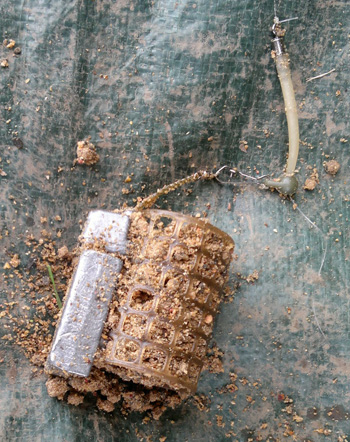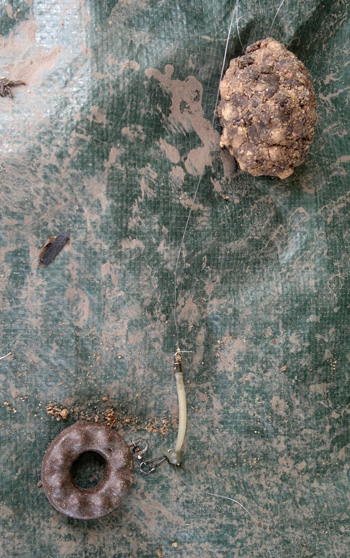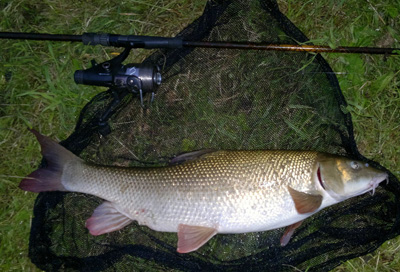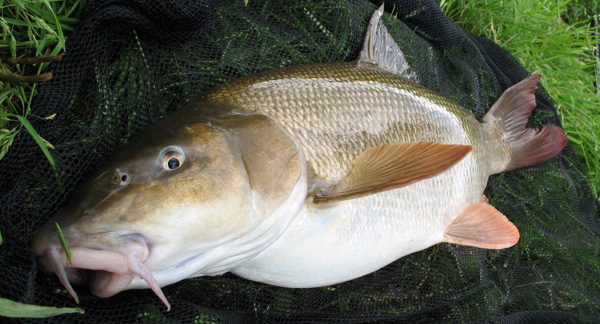“A1 pits anyone?” Lord Paul posted on the FishingMagic forums looking for a few people to join him for a session on the River Trent. I’d not fished this stretch before so I registered my interest. As is usual with these trips the numbers dropped steadily as the day approached. Still, a couple, Paul and Morespiders, were going to be there.
On the day of the trip I checked FM to find a message from Paul: “Sorry mate we’re not coming.” Billy No Mates packed his car and set off for the Trent. I don’t blame them really as the forecast was for gale force winds and heavy rain, with the Trent showing 1.5 metres on the gauge and rising.
Wimps!
Swim Selection
I arrive at South Muskham to find the river high and coloured. The first task is to find a swim that I can fish safely and which will give me a good chance of a barbel. Not having fished this length before I’ve no idea of what the river is like under normal conditions so I have to start from first principles.
The first thing I do is look for swims that have steadier, smooth flowing water close in. I’m not looking for still water or for an eddy, just a smooth steady flow. I then select a couple of swims that also give me room to play a fish. The last thing you want when you hook a big barbel in heavy flows is a tangle of branches just downstream of you.
The next job is to set up a rod with a 3oz lead. I check the depth in the margins to make sure I’ve got a reasonable depth and then I explore the swim, counting down the lead and feeling for evidence of what the bottom is like when I retrieve. The swim I select has a distinct step just off my rod tip, probably where you’d sit in normal conditions, and then drops off to around 10ft. The bottom is fairly level out to beyond where I intend to fish and I can feel an occasional grating sensation as I drag the lead back – a sure sign of gravel. There also appears to be a fair amount of blanket weed around, which is normal for the Trent.
Baiting Strategy
Now for the important bit!
Firstly I put a pint of 4mm pellets in a bait box, just cover them with water and leave them to soak. I next make up some method mix (Sonubaits 50-50 is good) liberally laced with 4mm pellets. This mix forms nice firm balls which will hold together until they hit the bottom. I feed four tangerine-sized balls of this mix just inside the crease where the steadier water meets the main flow. When doing this I assume that the groundbait balls will sink at an angle of 45 degrees, so in 10ft of water I feed them 10ft upstream of where I want them to hit bottom. I also assume that in this flow the balls will roll downstream for a bit before they break up so I actually feed them about 15 to 20ft above where my feeder will be. In slower flows the groundbait balls will drop at a steeper angle so I’d put them in further downstream.
 By this time the pellets I’ve left to soak will have absorbed most of the water and softened up nicely. I then add method mix until I get a nice dry mix that will only just hold together when squeezed into a cage feeder. This mix should stay in the feeder until it hits bottom and then explode out of it sending a trail of fishmeal particles downstream.
By this time the pellets I’ve left to soak will have absorbed most of the water and softened up nicely. I then add method mix until I get a nice dry mix that will only just hold together when squeezed into a cage feeder. This mix should stay in the feeder until it hits bottom and then explode out of it sending a trail of fishmeal particles downstream.
What I’m aiming to do is build a feeding zone with the balls of groundbait and create a trail of fishmeal particles from the feeder to attract fish from downstream. In flows like this the bait won’t stay too long in the feeding zone so I’ll top it up with a couple of balls of groundbait every couple of hours. If I start to catch I’ll feed a couple of balls after each fish. I’ll recast the feeder every 20 minutes or so. The hook bait is a couple of 10mm boilies on a hair.
Tackle
I’m fishing a 2.25lb test curve rod with 12lb line and a cage feeder. A few trial casts show me that adding 4oz of lead to a 30g Drennan Gripmesh feeder will just hold bottom. The feeder is attached by my own version of the Jan Porter rig with a thin tail rubber pushed over a swivel acting as the ledger stop and a John Roberts ledger bead which will just jam on the end of the tail rubber (see picture).
 In heavier flows I’d dispense with the feeder and use a heavy lead, moulding a ball of my method mix around the hook bait.
In heavier flows I’d dispense with the feeder and use a heavy lead, moulding a ball of my method mix around the hook bait.
Fishing
In these conditions I’m only going to use a single rod. I know that I’m potentially missing the chance of catching a fish further out, but it’s a lot less stressful when I hook a fish. In summer floods there can be a huge amount of debris coming downstream, forcing you to recast at regular intervals to clear the line. If I’m using two rods this can get a bit wearing to say the least so using one rod takes a bit of stress out of things and keeps me concentrating on catching fish rather than clearing rubbish!
I lob the heavily loaded feeder out to the crease and set up my bivvy. I’m not by nature a long stay angler and I like to stay mobile so I’ve got a 60inch brolly with an overwrap for bad conditions. I have a few exciting moments getting the brolly up in the gusty wind, but I’m soon relaxing in the shelter and preparing a welcome cuppa. 11.00pm arrives and I’m still without a fish and I decide to stop fishing and get some sleep. Leaving a rod out whilst I sleep is asking for a snagged fish. I set my alarm for 4.00am and retire for the night.
 I awake to a cold, grey dawn, feed four balls of groundbait and swing out the feeder. I’ve just made a nice cup of tea when the rod tip slams round. The barbel manages to find a clump of weed to take refuge in, but steady pressure eventually tells and battle commences. The only real worry is the build-up of rubbish on the line which threatens to jam in the tip ring. Thankfully the debris works its way down the line and I’m able to net a good fish. It weighs 10lb 2oz which makes a very nice start to the season. I’m not at my best at 4.30 in the morning and for some reason I took the pictures with my mobile rather than my camera so apologies for the poor picture quality!
I awake to a cold, grey dawn, feed four balls of groundbait and swing out the feeder. I’ve just made a nice cup of tea when the rod tip slams round. The barbel manages to find a clump of weed to take refuge in, but steady pressure eventually tells and battle commences. The only real worry is the build-up of rubbish on the line which threatens to jam in the tip ring. Thankfully the debris works its way down the line and I’m able to net a good fish. It weighs 10lb 2oz which makes a very nice start to the season. I’m not at my best at 4.30 in the morning and for some reason I took the pictures with my mobile rather than my camera so apologies for the poor picture quality!
After this things go quiet and by 6 o’clock I’m thinking of a move. I pack away the overwrap and my sleeping gear and tidy up in preparation. By 7.30 I’ve made up my mind and I sling the rest of my gear in the car and head off upstream to Newark Dyke.
The water in the dyke is really tanking through and I can’t find any smoother water. This time I pick a swim where I can present a bait at the downstream end of a reed lined stretch of water where the bank steps back into a shallow bay. There will be an area of steadier water just below the reeds at the mouth of the bay which should hold some fish. I drop four balls of groundbait down the edge so that they hit bottom just above the end of the reeds and follow with the feeder just a little further down at the mouth of the bay.
I’ve not long to wait before I’m playing a decent barbel which leads me a merry dance in the powerful flow. It’s in beautiful condition and weighs 7lb 7oz.
This fish has trashed my braid hook length so I switch to 11lb fluorocarbon. As I was returning the fish I noticed that the river had started to rise again and this was probably the cause of the long wait before my next fish. A few hours later the river tops out and starts to drop I get a run of smaller barbel. My 24 hours are nearly up and the lure of a curry in Bradford gets too much so I load my gear in the car and head for home.

Summary
Fishing a big river like the Trent when it’s in flood can be a daunting prospect, made even more so if you are new to a particular stretch. What I’ve tried to show in this article is that provided you stick to a few basic principles it’s still perfectly possible to fish effectively and to catch a few barbel.
The key points are:
• Choose a swim that is likely to be comfortable for the fish and that you can fish effectively. Don’t cause additional stress by fishing two rods – a single rod causes you less stress and will catch just as many barbel.
• Adopt a baiting strategy and stick to it. Know where your bait is hitting bottom and how it will behave on the bottom. Don’t over-feed, you can always add more bait but you can’t take it out. I’m continually amazed at how many people loose feed in flood water instead of using groundbait or a bait dropper. In these conditions I use a smallish feeder to keep a trickle of bait going in, but rely on groundbait to create a feeding area.
• Always be prepared to move. You’re not going to choose the right swim every time so make it easy to move if you need to.
One final point is that big rivers in flood are dangerous places. Be aware of whether the river is rising or falling and always make sure you have an escape route to higher ground.










